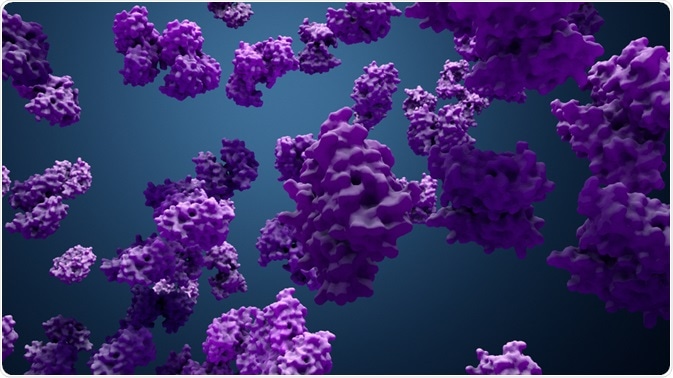Phase systems consisting of polymers or polymers with saltwater can be used to separate cells, membranes, viruses, proteins and other biomolecules. Aqueous two-phase systems, also known as ATPS, use the properties of the polymer surface and conformation of the materials to partition biomolecules.
Skip to:

Design_Cells | Shutterstock
What are aqueous two-phase systems?
The ability of polymer mixtures to separate phases was discovered in the 1950s, and has since then been applied to separate biomolecules. Phase separation occurs because most polymer pairs are not compatible in liquid solutions, therefore causing them to separate into two phases that are in equilibrium. Therefore, each phase contains water and one of the polymer types.
Biophysically, the phase separation of ATPS occurs due to the polymer’s high molecular weight working in tandem with interactions between parts of the polymers. Water forms noncovalent interactions with the polymers. Salt present in the mixture can influence the phase separation, by promoting separation at different salt concentrations.
ATPS has a wide range of uses, including analyzing biomolecules, cell surfaces, and interactions between the two, as well as cell population fractionation, recovery of products in industry, and waste treatments. While it has applications in both the laboratory and industrial setting, large scale applications are not as common as laboratory applications.
Aqueous Two-Phase Systems (ATPS)
Advantages of aqueous two-phase systems
ATPS are simple, fast, and relatively cheap systems, making them applicable to a number of applications. These systems can be used with both streams of smaller particulate matter and large volumes moving continuously with short contact times. Similarly, several types of ATPS exist, such as classic polymeric ATPS and ionic liquid-based ATPS.
In partitioning, ATPS is particularly powerful compared to methods such as centrifugation and electrophoresis. This is due to a large number of factors playing a role in partitioning, which results in ATPS being a highly customizable system. High selectivity is possible with ATPS by altering the properties of the system to give one interaction an advantage and make it predominant.
Some selectivity issues at the laboratory scale are still being resolved. For example, it has historically been more popular to extract protein at high purity from mixtures of polysaccharides and proteins than to extract polysaccharides only.
The development of methods for this purpose has shown high efficiency (as high as 100% for mannan polysaccharide recovery) and significantly higher efficiency than more popular affinity purification methods.
Disadvantages of aqueous two-phase systems
Predicting the partitioning of biomolecules in ATPS can be difficult. This is especially true for larger molecules. The macromolecules’ partitioning is more variable than that of smaller molecules because their distribution is decided based on several parameters of the phase system’s properties and that of the substance’s, as well as the interaction between the two. The number of parameters makes predicting partitioning complex.
ATPS are used in both laboratory and industrial settings. While purification has previously been an issue, developments in the field have increased purification factors for separating proteins from their contaminants. These have been successfully applied to the laboratory scale but not the industrial scale.
This shortcoming has been attributed to misunderstanding or lack of understanding of the systems or engineering involved. ATPS has struggled with large scale applications due to other issues, such as achieving the necessary selectivity during protein extraction, the price of the components forming the phase, and the required wastewater treatment associated with ATPS.
Sources
- Hatti-Kaul R. (2001). Aqueous two-phase system: A general overview. Molecular Biotechnology.
- Merchuka J.C., et al. (1998). Aqueous two-phase systems for protein separation: studies on phase inversion. Journal of Chromatography B: Biomedical Sciences and Applications. https://doi.org/10.1016/S0378-4347(97)00594-X
- Čížová A., et al. (2017). Efficient separation of mannan-protein mixtures by ionic liquid aqueous two-phase system, comparison with lectin affinity purification. International Journal of Biological Macromolecules. https://doi.org/10.1016/j.ijbiomac.2017.02.001
Further Reading
Last Updated: Apr 8, 2023